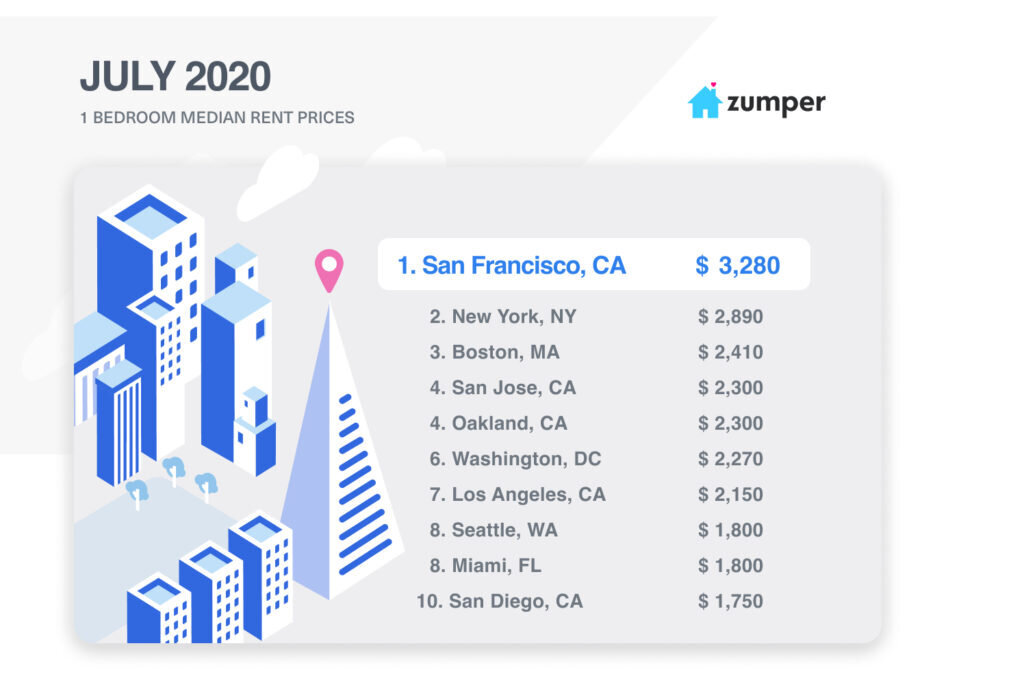Market Update: Are Oakland Tenants Paying Rent?
Will tenants pay rent?
Since April 1st, this angst-driven question has weighed heavily on every multifamily landlord in the Bay Area and beyond. While local and national reports indicate a strong, steady range between 86-95% of on-time payments – either at full or partial payment – most apartment owners have maintained a cautiously optimistic outlook, while paying special attention to the latest trends.
For owners in Oakland’s most desired submarkets – Adams Point, Lakeshore, Grand Lake, Piedmont Ave, Rockridge, Cleveland Heights and more – rents have been minimally impacted. According to the CoStar Group, Oakland rents are down 0.71%. In comparison, San Francisco, the Peninsula and South Bay submarkets are experiencing the opposite response, with 9-15% reductions.
Take a look at Zumper’s National Rent Report, released July 1st:
Credit: Zumper
While San Francisco remains #1 for highest median one bedroom rents in the nation, Oakland is tied with San Jose for the #4th highest. In general, multifamily as an asset class continues to out-perform expectations and other investment vehicles, with Oakland remaining one of the most resilient rental markets in the US.
Zumper’s second illustration below provides additional insights. Interestingly, Oakland is trending upward, with a 4.5% increase year over year for 1 bedroom apartments, and 4.8% growth for year over year for 2 bedroom apartments. Meanwhile, most cities are holding or tallying losses across the board.
Credit: Zumper
Nearly six months into our COVID19 era, the market-specific question becomes:
Why have multifamily assets in Oakland remained more competitive, with other markets experiencing fluctuation?
While San Francisco and South Bay markets revolve around technology-driven industries, Oakland’s broad-based economy has kept overall demand steady. Furthermore, Oakland and the East Bay at-large are considered value plays, both in the minds of employers and renters. With communal amenities and convenience to transportation and retail linkages no longer prioritized in the minds of tenants, continue to see ongoing shifts towards affordability, safety and space (both indoor and outdoor) – making Oakland and its inventory of smaller apartment buildings, in desired neighborhoods, the destination for those looking to remain in the Bay Area.
In the short-term, Oakland’s larger, modernized apartment developments will be hardest hit with steep rent concessions and signing bonuses to secure tenancies.
Additionally, higher vacancy rates from out-migration trends will become a common theme as well, especially if companies adopt flexible, voluntary work-from-home options.
Overall, Oakland’s smaller landlords are best positioned to compete by offering affordable rents; in quieter, safer neighborhoods; and with minimal human interaction with neighbors. During vacancies, stay flexible, consider adding parking and storage as “bonus” incentives, and always emphasize value. When and where possible, invest in building and unit upgrades, like in-unit laundry and the beautification of outdoor space.
As companies like Pacific Gas and Electric relocate headquarters from San Francisco to Oakland, and perhaps with other corporations and companies following suit, your portfolio will be poised to weather this storm, and capitalize on this time, far better than most.


